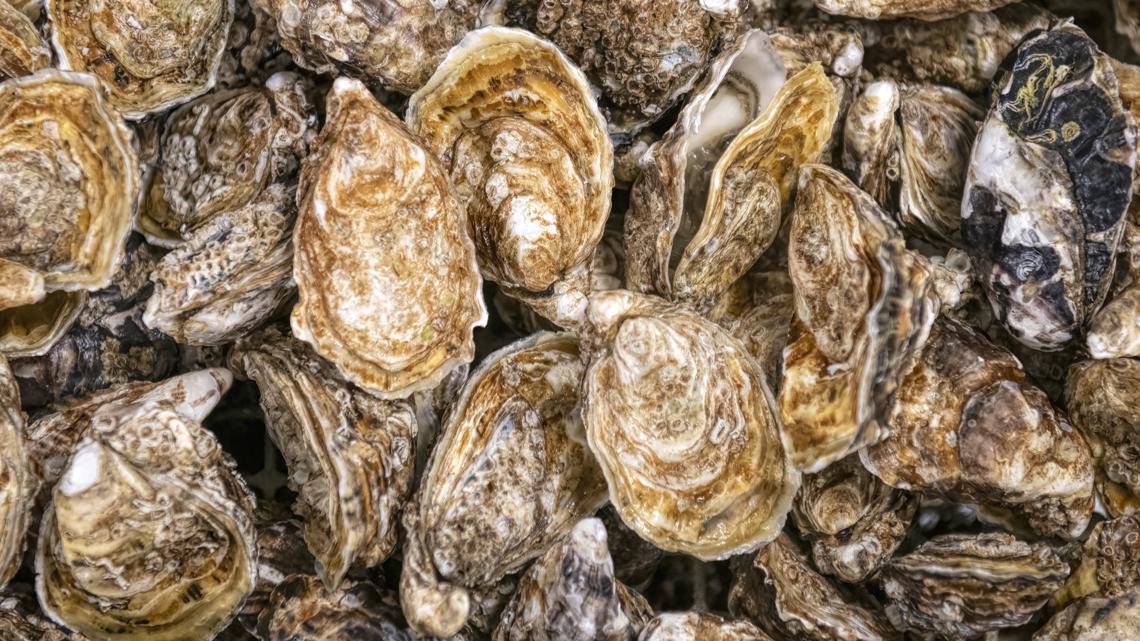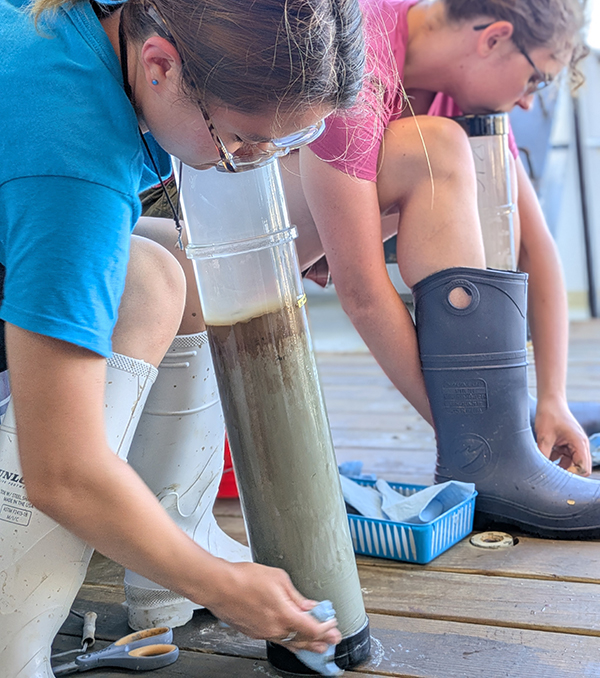Research shows freshwater fish like complicated shoreline environments, just as saltwater species do – KU News

Eco-Engineered Shorelines: Advancing Sustainable Development Goals Through Habitat Restoration
Executive Summary: Research and Sustainable Objectives
A recent study published in Aquatic Conservation: Marine and Freshwater Ecosystems details an innovative approach to shoreline management that directly supports several United Nations Sustainable Development Goals (SDGs). Research led by the University of Kansas and Carleton University investigates the use of eco-engineered seawall panels designed to mimic natural plant roots. The primary objective is to transform artificial waterfronts into thriving ecosystems, thereby enhancing biodiversity and water quality.
- Primary Goal: To reverse biodiversity loss in modified aquatic environments by creating complex habitats on artificial structures like seawalls.
- Methodology: Testing fish species’ preferences for concrete panels with varying levels of root-like complexity compared to traditional flat seawalls.
- Core Inspiration: The intricate root systems of mangrove trees, which have been largely replaced by artificial shorelines in many coastal areas.
Advancing SDG 14: Life Below Water
This research provides a direct and practical application for achieving the targets of SDG 14, which calls for the conservation and sustainable use of oceans, seas, and marine resources. By creating micro-habitats, the project aims to restore ecological functions in heavily modified freshwater and marine ecosystems.
Experimental Design and Key Findings
The study was designed to quantify the ecological benefits of the innovative panels for freshwater species.
- Test Subjects: Four species of freshwater fish were selected for the experiment: bluegill, rock bass, yellow perch, and banded killifish.
- Experimental Setup: Individual fish were placed in a test environment containing four distinct panel designs of increasing structural complexity, alongside a flat “control” panel.
- Performance Metric: The amount of time fish spent associating with each panel was recorded to determine habitat preference.
- Universal Preference: All tested species showed a significant preference for the complex, root-like panels over the conventional flat seawall surface.
- Species-Specific Behavior: Habitat preference for the most complex designs was species-specific. Bluegill and banded killifish demonstrated the strongest attraction to high-complexity panels.
- Versatility: Rock bass and yellow perch showed more versatile behavior, utilizing a range of relief depths for refuge.
- Critical Complexity: A key finding was that fish responded more positively once a “middle level” of structural complexity was introduced, establishing a baseline for effective design.
Contribution to SDG 6 (Clean Water) and SDG 11 (Sustainable Cities)
The project extends beyond biodiversity to address the interconnected goals of water quality and sustainable urban development. By retrofitting urbanized shorelines, this initiative helps create more resilient and ecologically sound communities.
- Water Quality Improvement (SDG 6): The panels are designed not only for fish refuge but also to provide attachment surfaces for water-filtering organisms, such as bivalves, which naturally improve water clarity and quality in canals and lakes.
- Sustainable Infrastructure (SDG 11): The research offers a solution for enhancing ecosystems in densely populated coastal and lakeside communities where artificial shorelines are a necessity for navigation and recreation.
- Community Engagement: Ongoing work includes outreach to waterfront property owners to promote the adoption of sustainable shoreline construction practices.
Fostering SDG 9: Industry, Innovation, and Infrastructure
This research exemplifies the principles of SDG 9 by developing resilient infrastructure through ecological innovation. It represents a shift from historically anthropocentric construction methods to a more holistic approach that integrates natural systems into the built environment.
- Biomimicry in Construction: The panel design is a prime example of biomimicry, applying lessons from natural forms (mangrove roots) to solve an engineering challenge.
- Eco-Engineering: The project transforms passive, “grey” infrastructure into active, “green” systems that provide measurable ecological services.
- Future Development: Continued experimentation with different materials and designs aims to optimize the panels for both freshwater and saltwater applications, promoting a new standard for sustainable construction.
Future Directions and Holistic Vision
The research team is expanding its work from controlled lab settings to real-world applications, including an ongoing study in a Canadian lake. The ultimate vision is to foster a paradigm shift in how human environments are constructed.
- Broader Application: The goal is to scale up these concepts for widespread adoption along developed shorelines globally.
- A New Design Philosophy: The project advocates for moving beyond human-centered design to embrace holistic approaches that address planetary needs, including biodiversity (SDG 14 & 15) and climate action (SDG 13).
Analysis of Sustainable Development Goals (SDGs) in the Article
1. Which SDGs are addressed or connected to the issues highlighted in the article?
- SDG 6: Clean Water and Sanitation
- SDG 9: Industry, Innovation and Infrastructure
- SDG 11: Sustainable Cities and Communities
- SDG 14: Life Below Water
- SDG 15: Life on Land
2. What specific targets under those SDGs can be identified based on the article’s content?
-
SDG 14: Life Below Water
- Target 14.2: “By 2020, sustainably manage and protect marine and coastal ecosystems to avoid significant adverse impacts, including by strengthening their resilience, and take action for their restoration in order to achieve healthy and productive oceans.”
Explanation: The article describes experiments with “reef wall” panels in Florida, where “the Atlantic Ocean and Gulf of Mexico meet the land.” The project’s aim to “enhance shoreline biodiversity” by creating artificial habitats on seawalls is a direct action toward restoring and protecting altered coastal ecosystems.
- Target 14.2: “By 2020, sustainably manage and protect marine and coastal ecosystems to avoid significant adverse impacts, including by strengthening their resilience, and take action for their restoration in order to achieve healthy and productive oceans.”
-
SDG 15: Life on Land
- Target 15.1: “By 2020, ensure the conservation, restoration and sustainable use of terrestrial and inland freshwater ecosystems and their services…”
Explanation: The research was expanded to include freshwater environments, as evidenced by the collaboration with Canadian scientists to test the panels with “freshwater fish” in “seawall-lined canals and lakes.” This directly addresses the restoration of inland freshwater ecosystems. - Target 15.5: “Take urgent and significant action to reduce the degradation of natural habitats, halt the loss of biodiversity and, by 2020, protect and prevent the extinction of threatened species.”
Explanation: The fundamental goal of the project is to combat biodiversity loss. The article states the hope is that the panels will be “improving species diversity” and that the researcher’s interest is in “how these ideas can be expanded upon to foster biodiversity.” The panels provide refuge for bait fish, directly addressing habitat degradation and protection of species.
- Target 15.1: “By 2020, ensure the conservation, restoration and sustainable use of terrestrial and inland freshwater ecosystems and their services…”
-
SDG 6: Clean Water and Sanitation
- Target 6.6: “By 2020, protect and restore water-related ecosystems, including mountains, forests, wetlands, rivers, aquifers and lakes.”
Explanation: The article explicitly mentions that a key purpose of the panels is to “improve the surrounding water quality” by “providing fish hiding places and surfaces for water-filtering bivalves to attach.” This is a direct effort to restore the ecological function and health of water-related ecosystems.
- Target 6.6: “By 2020, protect and restore water-related ecosystems, including mountains, forests, wetlands, rivers, aquifers and lakes.”
-
SDG 9: Industry, Innovation and Infrastructure
- Target 9.4: “By 2030, upgrade infrastructure and retrofit industries to make them sustainable… with all countries taking action…”
Explanation: The project involves creating innovative “root-inspired panels in concrete” to retrofit existing, ecologically-poor infrastructure like flat seawalls. The researcher, an architect, notes that “Construction technologies are historically anthropocentric and need to pivot toward more holistic approaches,” which aligns with making infrastructure sustainable.
- Target 9.4: “By 2030, upgrade infrastructure and retrofit industries to make them sustainable… with all countries taking action…”
-
SDG 11: Sustainable Cities and Communities
- Target 11.4: “Strengthen efforts to protect and safeguard the world’s cultural and natural heritage.”
Explanation: The panels are designed for “waterways that have been altered beyond any recognizable semblance of natural shorelines,” which are typically found in urban or developed areas. By reintroducing ecological complexity, the project helps restore the natural heritage of these constructed environments.
- Target 11.4: “Strengthen efforts to protect and safeguard the world’s cultural and natural heritage.”
3. Are there any indicators mentioned or implied in the article that can be used to measure progress towards the identified targets?
- Species-specific habitat preference: The study directly measured how different fish species (bluegill, rock bass, etc.) interacted with the panels compared to a control wall. The article notes, “Bluegill liked (or at least hung out near) those panels the most,” providing a quantifiable indicator of the habitat’s effectiveness for specific species.
- Fish response to complexity: Progress was measured by observing fish behavior in relation to the panel design. The article states a “key finding” was that “we could actually see fish responding more positively to the wall once you hit the middle level of complexity and upwards.” This serves as an indicator for optimizing the design.
- Improvement in species diversity: The overarching goal is “improving species diversity.” A direct indicator would be monitoring the number and variety of both plant and animal species that colonize the panels over time in a real-world setting, such as the ongoing study in a Canadian lake.
- Water quality improvement: The article implies that water quality can be measured as an indicator of success. The goal to “improve the surrounding water quality” by providing surfaces for “water-filtering bivalves” suggests that progress could be tracked by measuring water clarity, nutrient levels, or the population density of these bivalves on the panels.
- Adoption by property owners: The project’s real-world implementation can be measured. The article mentions “reaching out to waterfront property owners, doing surveys and trying to figure out what’s the best way to roll out ideas.” The rate of adoption of these panels by property owners would be a practical indicator of success.
4. Table of SDGs, Targets, and Indicators
| SDGs | Targets | Indicators |
|---|---|---|
| SDG 14: Life Below Water | 14.2: Sustainably manage and protect marine and coastal ecosystems. | – Species-specific habitat preference (e.g., time fish spend near panels). – Increase in local species diversity on altered coastlines. |
| SDG 15: Life on Land | 15.1: Ensure the conservation and restoration of inland freshwater ecosystems. 15.5: Halt the loss of biodiversity and reduce habitat degradation. |
– Positive response of freshwater fish species to panels. – Reduction in predator success against bait fish. – Colonization of panels by diverse plant and animal life. |
| SDG 6: Clean Water and Sanitation | 6.6: Protect and restore water-related ecosystems. | – Population density of water-filtering bivalves on panels. – Measurable improvements in local water quality (e.g., clarity, nutrient levels). |
| SDG 9: Industry, Innovation and Infrastructure | 9.4: Upgrade infrastructure to make it sustainable. | – Development of new panel designs using different materials. – Rate of adoption of sustainable seawall panels by property owners and developers. |
| SDG 11: Sustainable Cities and Communities | 11.4: Strengthen efforts to protect and safeguard natural heritage. | – Number of altered urban/suburban shorelines retrofitted with ecological panels. |
Source: news.ku.edu

What is Your Reaction?
 Like
0
Like
0
 Dislike
0
Dislike
0
 Love
0
Love
0
 Funny
0
Funny
0
 Angry
0
Angry
0
 Sad
0
Sad
0
 Wow
0
Wow
0












































































